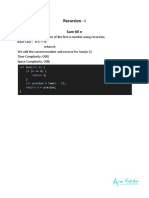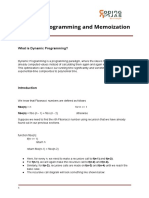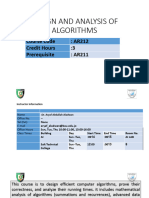0% found this document useful (0 votes)
7 views4 pagesDynamic Programing
The document discusses various approaches to calculate the Fibonacci series, including a brute force recursive method, an optimized recursive approach with memoization, a bottom-up dynamic programming method, and a space-optimized iterative approach. Each method is accompanied by its time and space complexity analysis, highlighting the efficiency improvements with memoization and iterative solutions. The final approach reduces space complexity to O(1) while maintaining a time complexity of O(n).
Uploaded by
codewithrohan9834Copyright
© © All Rights Reserved
We take content rights seriously. If you suspect this is your content, claim it here.
Available Formats
Download as DOCX, PDF, TXT or read online on Scribd
0% found this document useful (0 votes)
7 views4 pagesDynamic Programing
The document discusses various approaches to calculate the Fibonacci series, including a brute force recursive method, an optimized recursive approach with memoization, a bottom-up dynamic programming method, and a space-optimized iterative approach. Each method is accompanied by its time and space complexity analysis, highlighting the efficiency improvements with memoization and iterative solutions. The final approach reduces space complexity to O(1) while maintaining a time complexity of O(n).
Uploaded by
codewithrohan9834Copyright
© © All Rights Reserved
We take content rights seriously. If you suspect this is your content, claim it here.
Available Formats
Download as DOCX, PDF, TXT or read online on Scribd
/ 4

































































